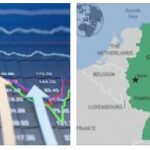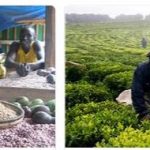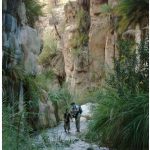Agriculture
Agriculture is still very important; it generates (2016) 2.1% of GDP. The regional differences are clearly evident in the number of employees (Northern and Central Italy: around 3%, Mezzogiorno: over 9%; Italy as a whole: 3.8%). About 13.2 million hectares, that is 43.8% of the country’s area, are used for agriculture; 51.1% of this is arable land, the rest is permanent crops and grassland. Small and very small businesses dominate the business size structure; the average farm size is 8.4 ha (comparison of EU countries: 18.5 ha).
The main crops are cereals, fresh fruit and vegetables as well as wine and olives. The largest closed cultivation area for pome fruit (especially apples) in Europe is located in South Tyrol. The fertile Po Valley and the areas leaning towards the Adriatic coast are centers of wheat and hybrid maize cultivation, while land maize is grown on the less fertile, non-irrigated soils in the south. Polenta made from land maize is a staple food, especially in Lombardy and Veneto. Rice is also grown in the Po Valley and on Sardinia (Italy is the largest rice producer in Europe). After the sugar beets, tobacco growing is taking offthe largest area among the commercial crops. Tobacco is mainly grown in Puglia and Campania. Potatoes are grown in all parts of the country, but play a far less important role as food and feed than in Central Europe. The most important vegetable is the tomato. It is followed by the artichoke, which is important for fresh consumption, but also as a preserve and for beverage production (cynar). Three quarters of the citrus fruits are grown in Sicily. Olive cultures can be found nationwide, with the exception of Northern Italy (Italy is the world’s second largest producer of olive oil), as well as viticulture (Italian wines). Even before France, Italy is the world leader in viticulture.
According to smber, the livestock industry (cattle and pig breeding) is particularly important in northern Italy. Sheep and goats are mainly kept in the south. Hides, skins, wool and cheese are the most important animal export products.
Forestry: Over a third of the total area is forested, but large parts of it consist only of groups of trees or bushes. In the south, holm oaks, pines, laurels and cypresses dominate, in the north conifers, oaks and chestnuts. In addition to wood (2015: 5.05 million m 3), the forests supply walnuts, chestnuts, mushrooms and truffles.
Fisheries: In coastal fishing, marine fish, molluscs and shellfish are landed with the fishing fleet (2015 catch: 347,000 t; mainly mussels, anchovies and sardines).
Vegetation
Northern Italy and the higher parts of the Apennines belong to the Central European deciduous deciduous forest area; Evergreen Mediterranean vegetation can already be found on the lakes at the edge of the Alps and on the Ligurian coast. In central Italy the hard-leaved plants reach up to 400 m, in southern Italy to over 800 m above sea level; in Sicily and Sardinia there is also the dwarf palm. This is followed by sweet chestnuts and oaks up to 1,200 m above sea level, red beeches and firs, in some cases pines. The tree line is between 1,900 m in the north and 2,100 m above sea level in the south. Unfamiliar floral elements are agaves, opuntias, cypresses, cedars, and eucalyptus. The forest has been greatly reduced: in the Po Valley through colonization, in the mountains through excessive use of wood and grazing. This led to hard-leaved bush formations (maquis), shrub heaths (garrigue), soil erosion and burial of valleys and estuary bays (Pisa, Sibaris), karstification of the limestone mountains and swamping. Cultivated plants such as olive trees, grapevines and grain determine the landscape today, in the Po Valley also meadows; The robinia has grown there outside of the usable areasspread out. Large wheat-growing areas were created in the south. Terraced cultivation in the mountains is declining in favor of afforestation (Alps, Apennines).
Natural resources
Italy is a country poor in natural resources. The oil reserves are estimated at (beginning of 2017) 556.7 million barrels. The current annual production of 3.8 million t comes mainly from the southern Adriatic. Natural gas is primarily extracted from the northern Adriatic and the Ionian Sea (total output in 2016: 5.3 billion m 3). In addition to fuels, feldspar, clay, pozzolan, limestone and marble are also important in mining. Lead, zinc and manganese ore as well as rock salt and gypsum are also mined.
Transportation
Italy has a well-developed transport network. The length of the railroad is around 16,800 km, of which around 12,000 km are electrified. Important railway lines lead, partly through tunnels, from Central Europe to the Po Valley. The Alpine crossings are of considerable importance for both long-distance passenger and freight traffic. The high-speed network (1,350 km) is still under construction.
The road network has a length of about 487 700 km; around 1.5% of this is on motorways and a good 4% on national roads. The very good and modern motorway network is one of the densest in Europe. The network is being expanded to include new motorways as planned and its performance improved. With the exception of some routes in southern Italy, the motorways are subject to tolls.
With a size of 16.5 million GT (end of 2015), the merchant fleet still plays a major role in international freight traffic. The most important ports are Genoa, Trieste and Naples.
The southern Italian port of Gioia Tauro in particular has gained in importance for container traffic in recent years. Crude oil pipelines (TAL and CEL) lead from Trieste and Genoa to Ingolstadt.
As in other European countries, air transport is becoming increasingly important. The most important international airports are Fiumicino (“Leonardo da Vinci”) near Rome, Linate in and Malpensa near Milan, Orio al Serio near Bergamo, Tessera (“Marco Polo”) near Venice and Fontanarossa near Catania.








